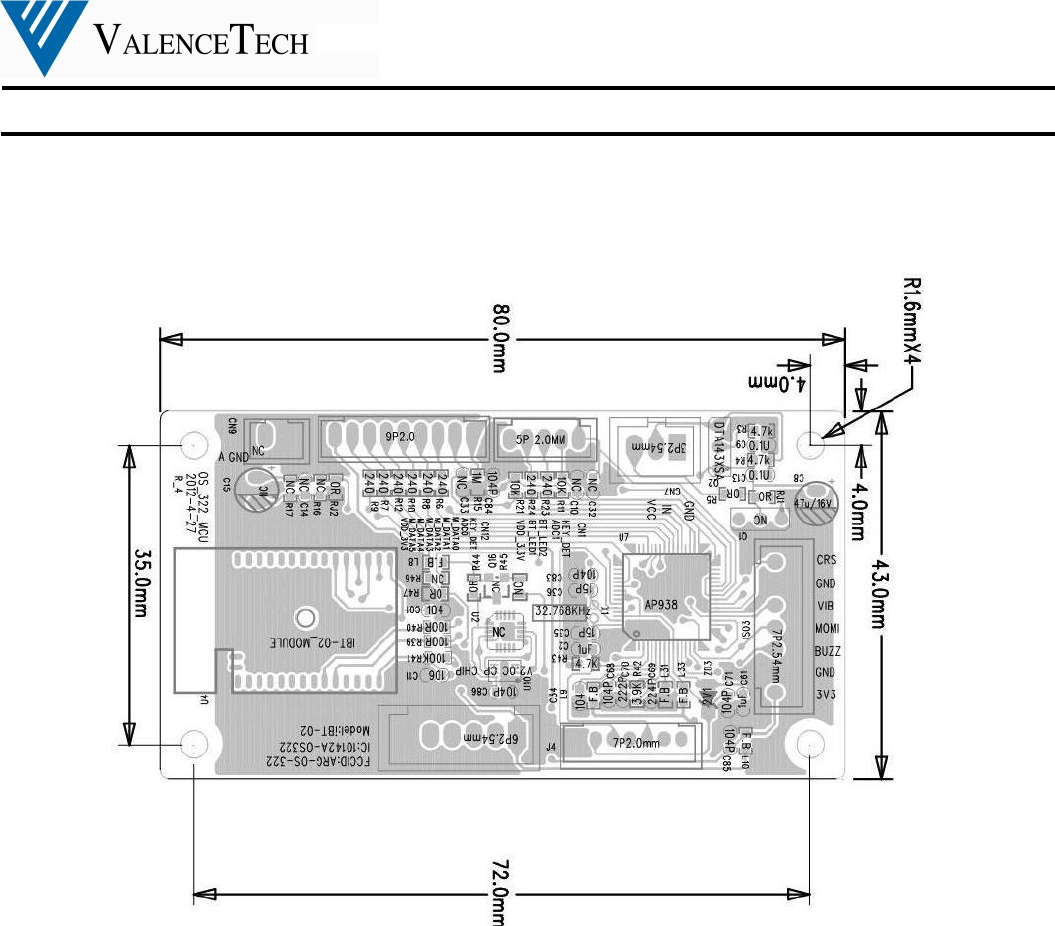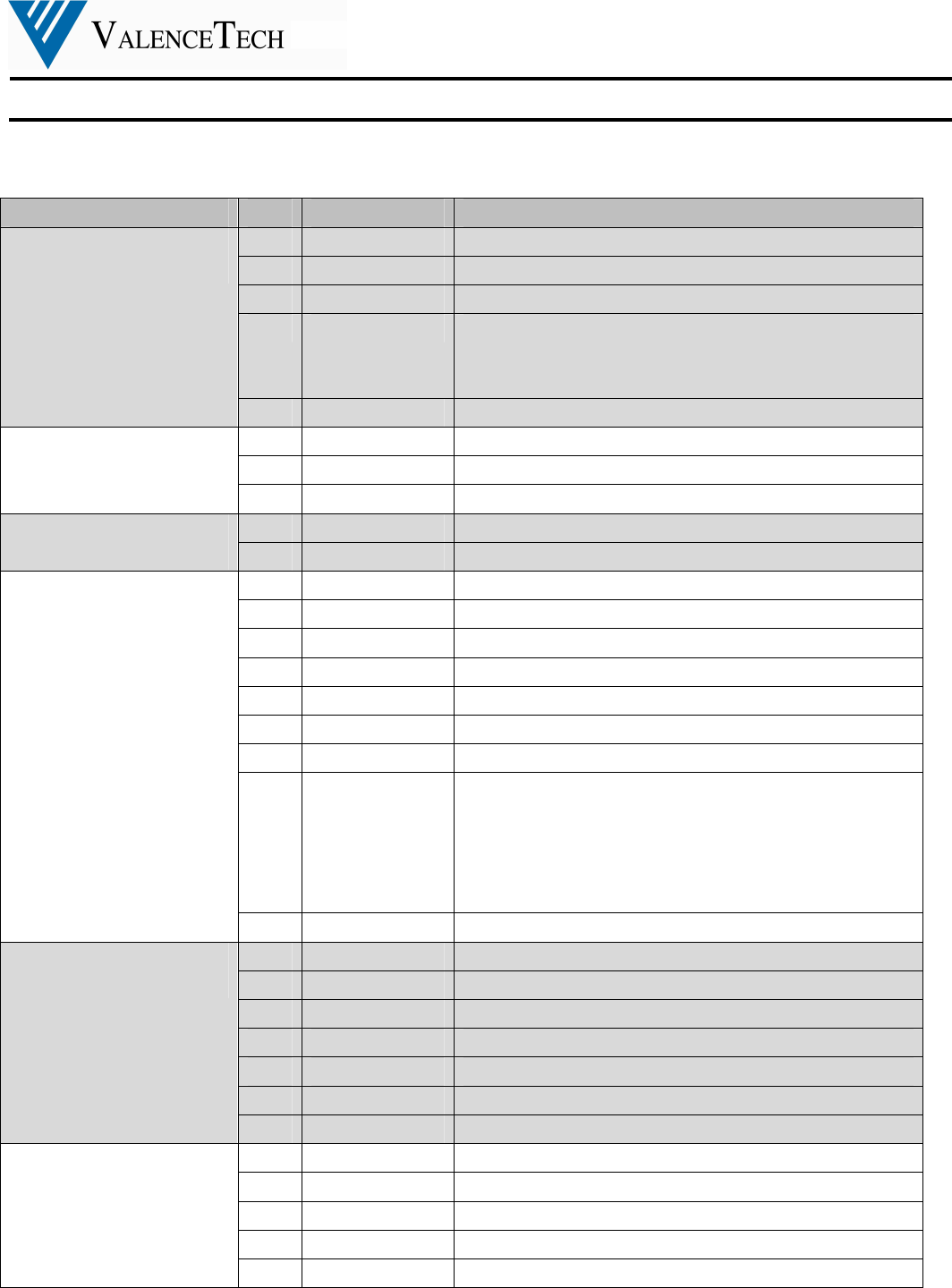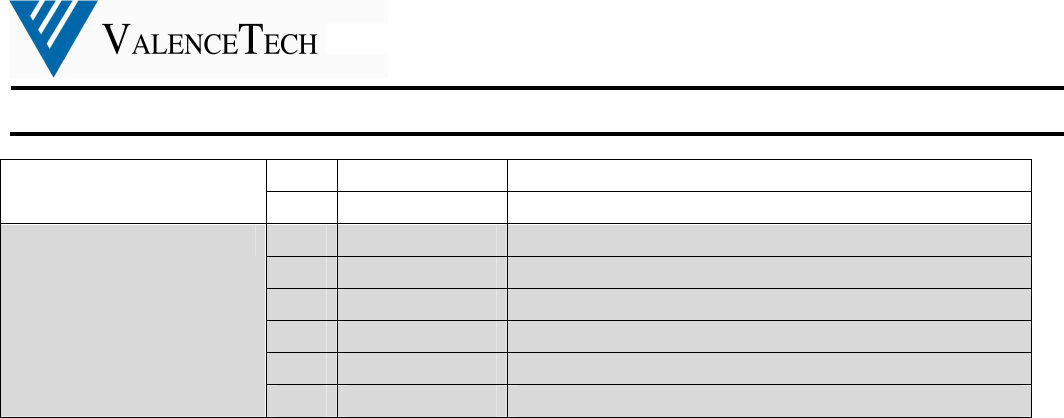OSIM OS-322 BT Module for Data Transfer User Manual Specifications of OS322 BT PCBA 1 June 26 2012
OSIM INTERNATIONAL LTD BT Module for Data Transfer Specifications of OS322 BT PCBA 1 June 26 2012
OSIM >
ARG-OS-322_User manual

Specifications of OS-322 MCU Board (Preliminary)
1
HARDWARE
Specifications
Frequency Band: Support for 802.11 co-existence
2.4GHz ~ 2.48GHz unlicensed band
Bluetooth System: v2.1 (Class 2)
Antenna: Class 2 power output with printed PCB antenna
Power: 3.3V from uSqueez App Power PCBA (2.7V to 3.6V)
RF: 1Mbps GFSK.
Interfaces : 7 connectors – CN1 – 5 pins (1 x 5 connector 2.0mm pitch)
CN7 – 3 pins (1 x 3 connector 2.50mm pitch)
CN9 – 2 pins (1 x 2 connector 2.50mm pitch)
CN12 – 9 pins (1 x 9 connector 2.0mm pitch)
ISO3 – 7 pins, 2.54mm (1 x 7 connector 2.50mm pitch)
J1 – 6pins (1 x 6 connector 2.54mm pitch)
J4 – 7 pins, 2.0mm (1 x 7 connector 2.0mm pitch)
Limit Safety Switch: A safety limit switch will be connecting to CN9. The safety limit switch is normally close
(GND) and makes the uSqueez App working normally. If the safety limit switch is opened
(Pull-high), the motors in uSqueez App will stop immediately and output beep sound twice.
Optical Sensor: The optical sensor is used to detect the wide and narrow position. It will be connected to
CN7.
Operating: 0 - 70°C
Temperature Range
Dimensions: 80mm x 43mm x 8.6mm
Indicators: 8 LEDs (on Button PCBs) – Power On/OFF (Color Red)
Vibration Hi (Color Red)
Vibration Lo (Color Red)
Soothe of Auto Mode (Color Red)
Pulse of Auto Mode (Color Red)
Energize of Auto Mode (Color Red)

Specifications of OS-322 MCU Board (Preliminary)
2
Bluetooth power indictor (Color Red)
BT connection status (Color Blue)
Buttons: 4 buttons (on Button PCBs) – Power On/OFF
Vibration Hi/Lo
Auto Mode
Bluetooth button
Current consumption: 50mA (approx.)
Under Industry Canada regulations, this radio transmitter may only operate using an
antenna of a type and maximum (or lesser) gain approved for the transmitter by
Industry Canada. To reduce potential radio interference to other users, the antenna
type and its gain should be so chosen that the equivalent isotropically radiated power
(e.i.r.p.) is not more than that necessary for successful communication.
Conformément à la réglementation d'Industrie Canada, le présent émetteur radio peut
fonctionner avec une antenne d'un type et d'un gain maximal (ou inférieur) approuvé
pour l'émetteur par Industrie Canada. Dans le but de réduire les risques de
brouillage radioélectrique à l'intention des autres utilisateurs, il faut choisir le type
d'antenne et son gain de sorte que la puissance isotrope rayonnée équivalente
(p.i.r.e.) ne dépasse pas l'intensité nécessaire à l'établissement d'une communication
satisfaisante.
Information for the OEMS Integrators
This device is intended for OEM integrators only. Please see the full grant of equipment document for
restrictions.
Label Information to the End User by the OEM or Integrators
If the FCC ID of this module is not visible when it is installed inside another device, then the outside of
the device into which the module is installed must be labelled with “Contains FCC ID: ARG-OS-322 and IC:
10142A-OS322”.

Specifications of OS-322 MCU Board (Preliminary)
3
MECHANICAL SIZE

Specifications of OS-322 MCU Board (Preliminary)
4
CONNECTOR PIN LAYOUT
Connector Pin Signal Name Description
CN1
(To Push Button PCB - BT)
1 VDD_3V3 3.3V power for LED
2 BT_LED1 Bluetooth LED1 enable / disable
3 BT_LED2 Bluetooth LED2 enable / disable
4 ADC1 Detect Push button according to input voltage level
No button press : 0.28×VDD to VDD
Bluetooth button: 0V to 0.28×VDD
5 KEY_DET Push button press detect
CN7
(To Optical Sensor)
1 SENS_VDD 3.3V Power for Sensor
2 OPT_IN Input signal from Optical Sensor
3 GND Signal Ground
CN9
(To Safety Limit Switch)
1 SAFE_DET Safety Limit Switch detection input
2 GND Signal Ground
CN4
(To Button PCB - Function)
1 VDD_3V3 3.3V power for LED
2 M_DATA5 LED5 enable / disable
3 M_DATA4 LED4 enable / disable
4 M_DATA3 LED3 enable / disable
5 M_DATA2 LED2 enable / disable
6 M_DATA1 LED1 enable / disable
7 M_DATA0 LED0 enable / disable
8 ADC0 Detect Push button according to input voltage level
No button press: 0.90×VDD to VDD
Vibration button: 0.59×VDD to 0.90×VDD
Power button : 0.28×VDD to 0.59×VDD
Program button : 0V to 0.28×VDD
9 KEY_DET Push button press detect
ISO3
(To Power PCBA)
1 VDD 3.3V Power supply from power board (2.7 to 3.6V)
2 GND Signal Ground
3 O_BUZZER Buzzer control signal to power board
4 O_MOMI Massage motor control signal to power board
5 O_VIB Vibration motor control signal to power board
6 GND Signal Ground
7 ZERO_CRS Zero cross signal from power board
J4 1 GND Signal Ground
2 3V3 Control Signal for MCU firmware upgrade
3 PGM Control Signal for MCU firmware upgrade
4 SDO Control Signal for MCU firmware upgrade
5 RESET Control Signal for MCU firmware upgrade

Specifications of OS-322 MCU Board (Preliminary)
5
6 SDI Control Signal for MCU firmware upgrade
7 SCK Control Signal for MCU firmware upgrade
J1 1 BT_3V3 Control Signal for BT module firmware upgrade
2 MOSI Control Signal for BT module firmware upgrade
3 MISO Control Signal for BT module firmware upgrade
4 CSB Control Signal for BT module firmware upgrade
5 CSK Control Signal for BT module firmware upgrade
6 GND Signal Ground
Caution:
This device complies with Part 15 of the FCC Rules. Operation is subject
to the following two conditions: (1) this device may not cause harmful
interference, and (2) this device must accept any interference received,
including interference that may cause undesired operation.
Le présent appareil est conforme aux CNR d'Industrie Canada applicables aux
appareils radio exempts de licence. L'exploitation est autorisée aux deux conditions
suivantes : (1) l'appareil ne doit pas produire de brouillage, et (2) l'utilisateur de
l'appareil doit accepter tout brouillage radioélectrique subi, même si le brouillage est
susceptible d'en compromettre le fonctionnement.
Changes or modifications not expressly approved by the party
responsible for compliance could void the user's authority to operate the
equipment.
This equipment has been tested and found to comply with the limits for
a Class B digital device, pursuant to part 15 of the FCC Rules. These
limits are designed to provide reasonable protection against harmful
interference in a residential installation. This equipment generates
uses and can radiate radio frequency energy and, if not installed and
used in accordance with the instructions, may cause harmful interference
to radio communications. However, there is no guarantee that interference
will not occur in a particular installation. If this equipment does cause
harmful interference to radio or television reception, which can be
determined by turning the equipment off and on, the user is encouraged
to try to correct the interference by one or more of the following
measures:
—Reorient or relocate the receiving antenna.
—Increase the separation between the equipment and receiver.
—Connect the equipment into an outlet on a circuit different from that
to which the receiver is connected.
—Consult the dealer or an experienced radio/TV technician for help.